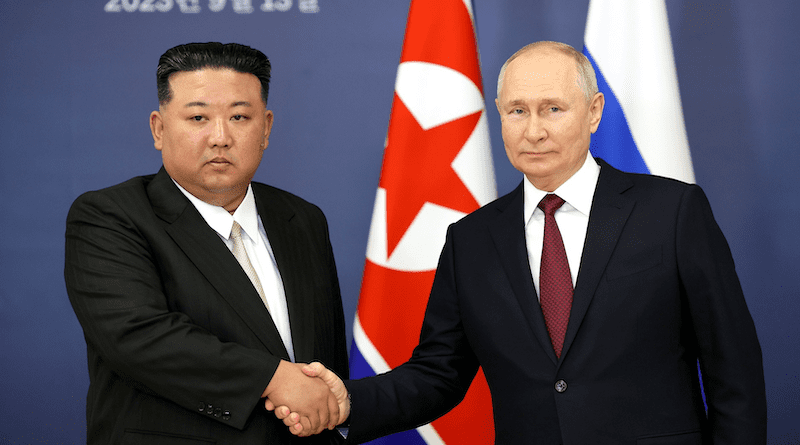Diplomatic Shifts Belie Continuity In North Korea – Analysis
By Andrei Lankov
In 2023, North Korea continued the foreign policy line it has followed since the failed attempt to compromise with the United States, undertaken during the former Trump administration. The year was marked by four significant shifts in diplomacy, though these shifts might be less important than they appear.
First, North Korea’s domestic policy was largely shaped by the rivalry between the United States and China. Around 2019, amid deepening confrontation with the United States, China deemed it necessary to maintain stability in North Korea, viewing it as a strategic buffer zone, and began providing aid. This aid, though modest and unlikely to spur economic growth, was enough to prevent the North Korean economy from collapsing since such collapse could lead to a regime implosion and put stability at risk. North Korea has a long record of mistrust towards China, but in their current situation they have few alternatives.
The United States is likely to maintain a hardline attitude — and the UN-imposed sanctions regime makes economic interactions with other countries highly difficult. The sanctions cannot be lifted without North Korea’s serious concessions on nuclear issues, and such concessions are unlikely. North Korean leaders see nuclear weapons as guaranteeing their long-term political and physical survival.
There is little hope for the revival of intra-Korean ‘cooperation’. In practice, this has always been a thinly disguised form of aid shipped from the wealthy South to the impoverished North. The right-wing government in Seoul has also adopted a hardline stance towards Pyongyang. But even a more liberal South Korean government would not dare violate the UN sanctions regime — and would be unable to provide North Korea with more meaningful aid.
With access to Chinese support, North Korea revised its economic policy, halting the economic reforms it pursued from 2012 to 2019. These reforms are now seen as potentially risky since they are likely to unleash difficult-to-control market forces. The government’s efforts are now focused on reviving the centrally planned economy of the 1970s. It is economically inefficient, but enhances state control.
Second, North Korean Supreme Leader Kim Jong Un appeared to be laying the foundations for the next dynastic transition. He was often seen in public with his daughter, who is believed to be named Kim Ju Ae. This girl, aged around 11 or 12, is deliberately placed at the centre of significant public events.
The most plausible explanation for the sudden prominence of one of Kim’s reported three children is that she is being groomed as the next successor. Choosing a woman is somewhat unusual, but Kim has a track record of promoting women to key political positions. But it will take 10 to 15 years before her anointment is possible, so she is merely a candidate. Should Kim become incapacitated in the near future, his most likely successor is his younger sister Kim Yo Jong.
Third, 2023 also saw Russia’s re-emergence as a major player in North Korea. In late July, Russian Defence Minister Sergei Shoigu made an unexpected visit to North Korea. In September, this was followed by Kim’s own trip to the Russian Far East where he had talks with Russian President Vladimir Putin. And in October, Russian Foreign Minister Sergey Lavrov visited Pyongyang.
The interactions between Russia and North Korea have been predominantly military focused. Reports surfaced in late 2022 about potential shipments of North Korean ammunition to Russian forces in Ukraine. By August 2023, there was little doubt these shipments had commenced. Given the acute shortage of ammunition both sides in Ukraine are now experiencing, these shipments might matter.
Kim’s visit to Russia hinted at the possibility of deeper military cooperation between Russia and North Korea. The summit was held at a space launch site, and the locations visited by Kim were primarily military sites. Rumours have also circulated about transfers of Russian military technology to North Korea, including ballistic missile development technology. But one must approach these reports with scepticism, as such transfers could contradict Russia’s national interests.
It is more plausible that these deliberate hints of military cooperation are intended to exert pressure on the United States and South Korea. Given South Korea is a major weapons exporter, it seems Moscow aims to influence Seoul’s policy towards the war in Ukraine. Moscow’s suggestion is that potential South Korean arms shipments to Ukraine could provoke technology transfers from Russia to North Korea.
Finally, North Korea slowly reopened after nearly three years of quarantine. This process began in March 2023, with the entry of the new Chinese ambassador to Pyongyang. This was followed by visits from Russian and Chinese delegations in July, leading to a partial opening of North Korean borders from late August.
Since then, a significant number of North Korean citizens stranded abroad for three years were able to return. North Korea also resumed air services to Russia and China. Yet this reopening is highly selective, seemingly restricted to Russian and Chinese officials and diplomats. The number of operating embassies remains small — half a dozen instead of the 23 to 25 permanent embassies before the COVID-19 outbreak.
North Korea remains largely self-isolated and has renounced its brief foray into reformist policies. But it can now count on the support of China and, to a lesser extent, Russia. Both donors are capable and willing to sustain the country indefinitely. For better or worse, the Kim family has maintained unprecedented stability in turbulent times.
About the author: Andrei Lankov is Professor at Kookmin University, Seoul, and Director of NK News.
Source: This article is part of an EAF special feature series on 2023 in review and the year ahead.

